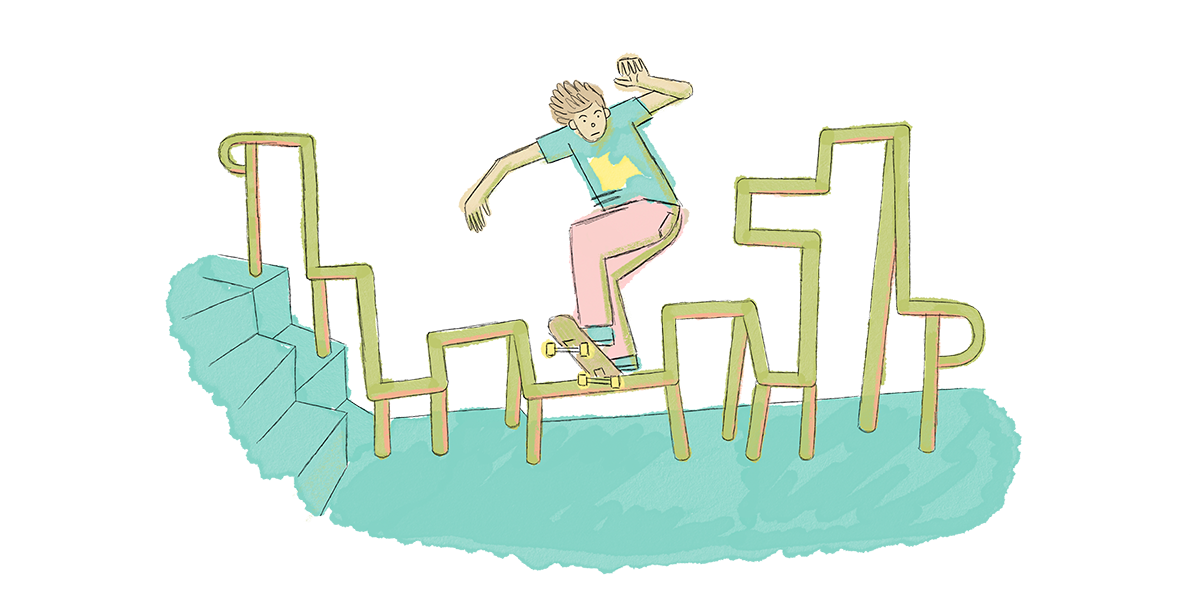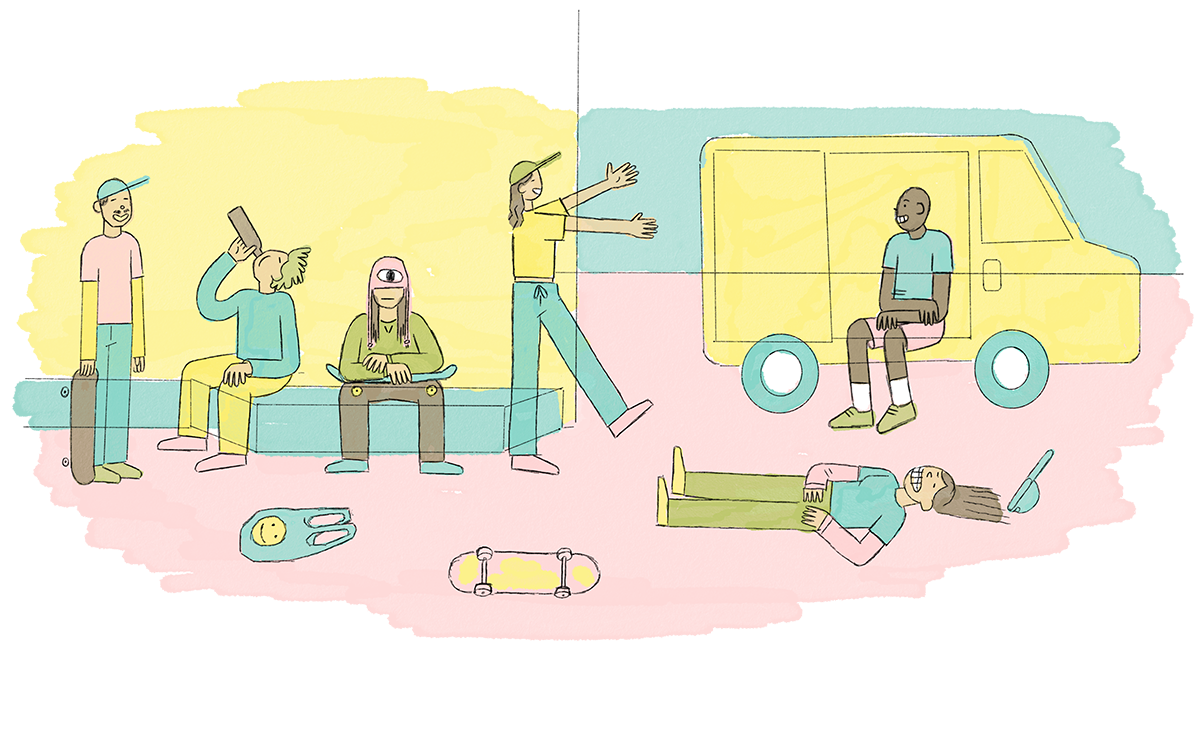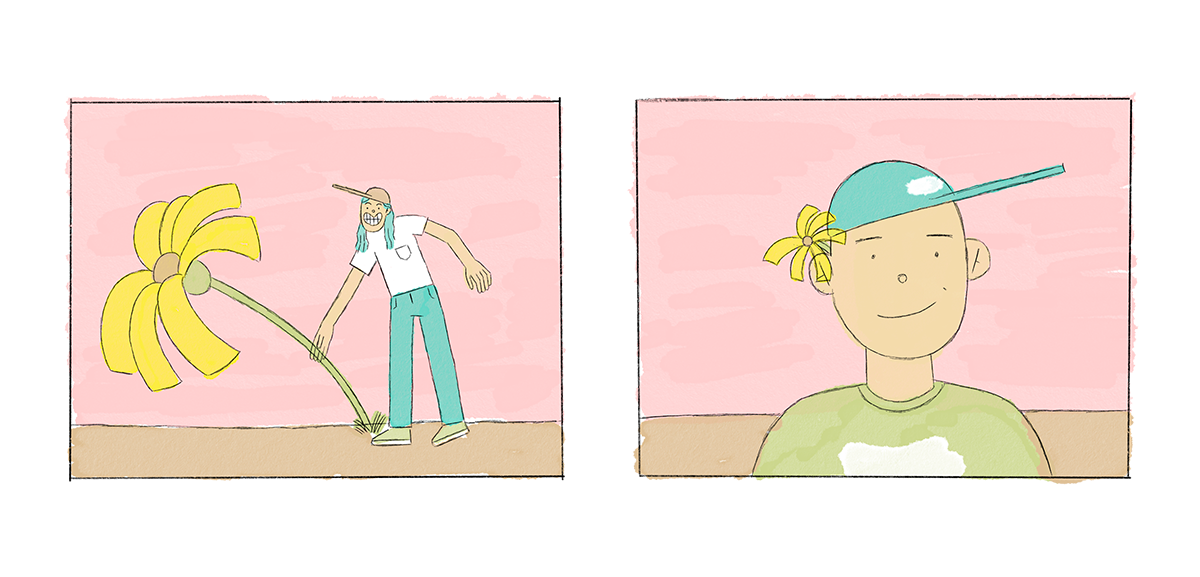Real life happens in between
Don Luong on Toy Machine’s "Real Life Sucks" and making skate videos with heart.

Don Luong has been making skateboarding videos for longer than some of the stars of his most recent project, Toy Machine Skateboard’s Real Life Sucks, have been alive. At 36, over half his life has been spent on the road, behind a camera, and stationed at the editing suite, toiling over keyframes and audio cues. It’s a path he started on in familiar earnest. After a brief hiatus from skating in high school, he returned to the fold and a Southern Californian cohort who had since levelled up in skill. As the spots they ventured to got gnarlier and further out of reach, he assumed the role of filmer. He took to it.
Independent videos like 2010’s Ta-Ha, which featured sections from a young Nick Garcia and Billy Davenport, would get his name out there. He’d eventually start working with Tum Yeto in 2012, the storied distribution company home to brands like Foundation Skateboards and the aforementioned Toy Machine. Twelve years later, Luong is still there, now a creative director and a director-director. Real Life Sucks — which takes its name from artist and Toy Machine founder Ed Templeton's speech-bubble musings scrawled on photographs of people staring into their phones — marks his 12th full-length feature across independent and professional projects.
Numbers-wise, that’s a canon that rivals any filmmaker working in skateboarding today. Impact-wise, his run of Foundation titles — Oddity (2017), Souviner (2018), Star & Moon (2021), Splendor (2022), and Whippersnappers (2023) — has helped breathe new life into a brand that’s been around since 1989. He just made a Toy Machine video in 2024 that feels like one from 1994 but still stands on its own. These are no small feats. Relevancy is a currency that’s hard to come by in an industry as mercurial as skateboarding. Yet these brands remain. As does Luong. Yes, that’s because he’s good at his job, but he’s also managed to figure something else out. His videos are more than highlight reels set to music. There’s some greater vein of purpose running through them. Or, in more direct terms, they have heart.
Luong would tell me that he was eager to chat because he doesn’t often get the opportunity to talk about his work, which is surprising but fortunate for me because there was something I wanted to know. How does he get a skate video to make you feel something?

Making a skate video sure gets Luong to feel something. Like “clockwork,” a few weeks into the process, doubt, stress, and anxiety set in. It becomes a full “existential crisis.” The same questions hang over everything, “Is this good enough? Gnarly enough? Do people even care? What am I doing with my life?”
Given the nature of his job, where he is constantly moving from project to project (on top of the non-skateboarding-related film work he does to supplement his income), that means those feelings are never far away. Real Life Sucks took roughly two years to complete, but in reality, the process never ends. There is always skateboarding to be captured, so “you compile, you compile, you compile, you compile.”
Those stockpiled tricks can often find life and use far outside of their initial chronology. “[There are] clips in Real Life Sucks that Myles Willard had [filmed for 2021’s] Vaccine or Scorched Earth, and didn't get used, so they ended up in this part.”
In the timeline, time becomes malleable, folding in on itself, bringing the past into the present. If there isn’t an obvious giveaway — like a change in hairstyle or noticeable departure in dress — it can be difficult for the viewer to notice when a trick has happened, as clips become stripped of context when they’re pieced together. For the most part, we see just quick flashes of achievement. It’s easy to forget that real life happens in between.
Since his The Re-education of Jeremy Leabres debut PRO part for Toy Machine in 2014, Leabres has endured a crushing succession of three knee surgeries and an ankle surgery on top of the constant wear-and-tear of skateboarding. Ten years on, and through it all, he arguably has the standout section in Real Life Sucks. Luong says he left five minutes of Leabres footage on the cutting-room floor for the sake of time. It’s a showing that is much more than a return to form; it’s a testament to Leabres’ fortitude and a reminder of the storylines running underneath the surface of any skateboarding video.
Consider recent Toy Machine roster addition Cordano Russell. In the span of a year, he’s gone from a virtual unknown to Thrasher releasing a mini-documentary that paints him as not just the hot new thing but a type of super-athlete that is new to skateboarding entirely (which his tricks in Real Life Sucks attest to). In the feature, we learn in detail about Cordano’s history, family, and unabashed Christian faith (“feeling good, feeling great, holy spirit activate,” Cordano repeats to himself before grinding a massive handrail), the latter something you might think would be at odds with a company whose graphics have depicted everything from Jesus and Lucifer “burying the hatchet” to a rendering of The Last Supper with Ed Templeton’s iconic Demon character in Jesus’ place. “Skateboarding is not a sin,” Cordano assures us with a laugh.
In that same amount of time, Braden Hoban has found himself in the role of ascendant superstar, winning major competitions, scoring lucrative energy drink sponsors, and being on the brink of competing for Team USA at the Paris 2024 Olympics, all of which happens off-screen. On it, he closes out Real Life Sucks in signature jaw-dropping fashion.
Those are things left unsaid, but any video worth its salt will have easter eggs, real or imagined, for fans to pick apart. There are the not-so-subtle ones, like Geoff Rowley holding up a Toy Machine board with his name on it, announcing his addition to the roster. But drill down, and it also speaks to the collapse of his board brand, Freedome, and harkens back to decades of friendship with his new boss, Ed Templeton.
Or what to make of Axel Cruysberghs’ subtle shift in style, slowly moving away from his usual barrage of massive handrails to creative, quick-footed wizardry that makes one wonder if injuries have forced him to take less impact or if the high-impact skating lost his interest.
Then there’s the arrival of Shiloh Catori, Susie Heath, and new PRO, Georgia Martin. In Real Life Sucks, they are presented as more than novel attractions — the cliched “token female skateboarder.” For starters, there are three of them. Catori and Martin each produced full, full-throttle sections, and Luong made sure to show them as they are: a part of the team. In b-roll, they’re in the van, in the background of clips, jumping and hounding their teammates with joyous fervour when they ride away.

When I asked Luong what it was like to watch the three not just get on the team but receive the time and resources from their sponsors that have allowed them to come into themselves and their abilities in a way that’s only recently become commonplace in a historically male-dominated industry, he warned me that he might get misty-eyed, and then he did.
“This question makes me really emotional because, you know, I've been doing this for a very long time and I thought I had it figured out. It was like a formula: meet the kid, bring up the kid, watch him do his thing, try to get him a sponsor… he goes crazy, goes pro, whatever. But with girls and women, [the day-to-day] of the process is so different.
"I've gotten really close to the women on Toy Machine, and it's almost more rewarding these days to get tricks with [them] and see how hard they work for their clips… a lot more thought has to go into [finding spots and getting tricks]. It's given me new life in what I do because it's sparked this whole different kind of skating for me if you will. They're like my sisters, and I'm so stoked that people are recognizing them as skaters, not ‘women skaters,’ but skaters. They're so talented, so gnarly, and so fun to be around.”
These are the currents flowing beneath the cuts, swirling and pulling the viewer deeper if they're aware. All this life happens amidst Luong’s “perpetual state of existential crisis.” His crisis is without a silver-bullet solution, but there is a balm that perspective applies.
“How I break through that feeling is just being grateful and appreciative of where I am [and] remembering this position that I've been blessed to sit in for a long time. I couldn't name many filmmakers in skating who have stayed at their company for over five years, let alone 12. And the little things like surprising Georgia Martin by turning her pro, helping skaters get shoe sponsors, helping skaters put together video parts, [and just] looking around and remembering why I do what I do because 99% of the skateboard industry is not going to be rich or even make a living off skating.”
That’s real life. Does it suck? Sometimes, but not always. Not in all ways.
Pontus Alv told Caught in the Crossfire that in making In Search of The Miraculous, “I am searching for the light in life, trying to see the beauty and the big picture… I like to mix in personal elements in my films. For me, skateboarding is more than just tricks and I try to define the bigger picture. Everything we go through in life matters: our history and our present, our dreams, our future thoughts, our love life, work, friends and so on.”
It’s those things we go through — the things that matter — that we connect to more deeply as viewers. That can make a skateboarding video feel like more than just the skateboarding in it. Sometimes, that can even be the pull of effective branding, like Ed Templeton’s signature illustration style that bleeds into every corner of a Toy Machine project. It’s an illustrated world skateboarders have grown comfortable with over the company’s thirty-plus years of existence. His words crawling from mouths, subliminal messages flashing across the screen, Transistor Sects mutilating one another with glee. Many of those graphics we see on screen in Real Life Sucks are pulled from old board designs and ad layouts left sitting in an assets folder on a computer — history once again repurposed.
But most affecting are the human moments. Luong understands this. For one, because “I'm a very sensitive guy. So, you know, I feel things. I feel lots of feelings.” He also considers that personal touch a show of respect for how personal the act of making a skateboarding video is. “I don't think filmmakers get enough credit for how much blood, sweat, and tears goes into making a full-length video.”
So we see moving shots of Ariana Spencer’s daughter and Luong’s wife and dog in Foundation’s Whippersnappers. “Who puts their wife in their skate video?” Someone attuned to a frequency that picks up on more than just “hammers.” Those are important too, of course, as a Hoban frontside-bluntside down a handrail with innumerable kinks will undoubtedly make you feel something — shock and awe, likely — but if the people doing the trick or are in the background of said trick feel like real human people who belong to a real human world, the trick itself becomes so much more.
This isn’t an obscure or esoteric approach to filmmaking. Luong works at a company with a decades-spanning catalogue. You can feel the influence of Jon West’s art direction in Foundations Art Bars Subtitles and Seagulls (2001) in Luong’s work. Same with Kevin Barnett’s from Toy Machine’s Good & Evil (2004). But as they do, Luong has his own distinct vision. One that’s gentler, perhaps. The skateboarders he presents on screen are made to be seen as more than stunt people whose sole purpose is our entertainment and the promotion of a brand — even if that is precisely the parameters of the deal from a consumer perspective.

In Real Life Sucks, we are shown genuine camaraderie. Group rapture upon an individual’s riding away. Moments of candid contemplation and blithe revelry. It’s the recognition of skateboarding being about more than just skateboarding. It’s the places it takes you, the people it brings into your life, and the memories it strings along that life like garlands. We see Shiloh Catori place a flower behind Luong’s ear and then ride her skateboard off a roof. At its best, this is what skateboarding is: an excuse to live.
Luong says people have told him that his films brought them to tears. Can a kickflip-crooked-grind on a handrail do that on its own? Maybe if done by the Madonna herself. But if seasoned with context and affection and finely-tuned aesthetic and watched by a crowd in a raucous theatre for the first time — “the premiere, seeing it live, seeing the reactions of the crowd and hearing the loud music. It's what I do it for, dude… You wish that you could premiere it for the entire world at once. That's what makes it worth it, which sounds insane, spending two years to celebrate for one night” — it is reasonable, and even responsible to whatever soul or spark is carried in the bony carriage of our chests, to take the invitation offered by the glowing screen and feel something.
So, how does Luong get a skate video to do that? In more direct terms:
“I just care. I think it's easy to make good art when you care.”





